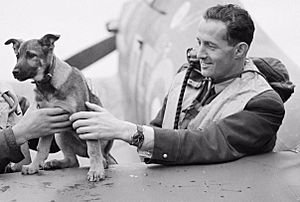Mirosław Ferić facts for kids
Quick facts for kids
Mirosław Ferić
|
|
|---|---|
 |
|
| Born | 17 June 1915 Travnik, Bosnia and Herzegovina, Austria-Hungary |
| Died | 14 February 1942 (aged 27) Northolt, Middlesex, England |
| Allegiance | |
| Service/ |
|
| Years of service | 1938-1942 |
| Rank | Flight Lieutenant |
| Service number | P-1387 |
| Unit | 111th Fighter Escadrille No. 303 Polish Fighter Squadron |
| Battles/wars | Polish Defensive War, World War II |
| Awards | Virtuti Militari; Cross of Valour; Distinguished Flying Cross (UK) |
Mirosław Ferić (born June 17, 1915 – died February 14, 1942) was a very brave fighter pilot from Poland. He became a famous "flying ace" during World War II. A flying ace is a pilot who shoots down many enemy planes.
Contents
Early Life
Mirosław Ferić was born in a place called Travnik. This was in a region known as Bosnia and Herzegovina. His father was from Croatia, and his mother was Polish. Sadly, his father passed away during World War I.
In 1919, when Mirosław was young, his family moved to Poland. He grew up there and later joined the military. In 1938, he finished his training at the Polish Air Force Academy. He became a fighter pilot and joined a special group called Escadre No. 111.
A Brave Pilot in World War II
Defending Poland (1939)
In September 1939, World War II began when Germany invaded Poland. This was called the Polish Defensive War. Mirosław Ferić and his squadron helped defend the city of Warsaw.
On September 3, his plane was damaged during a fight. He had to bail out, which means he safely parachuted from his aircraft. A few days later, on September 8, he helped shoot down an enemy plane.
Escape and Service in France
As the war continued, Mirosław and other pilots were told to go to Romania. He was held there for a short time, but he managed to escape. He then traveled by sea to France.
In France, he trained on French planes. He joined a flight group that protected aircraft factories. However, he did not get into any air battles there. When France was defeated in June 1940, Mirosław went to Great Britain.
Joining the Battle of Britain
In Britain, Mirosław received more training with the RAF (Royal Air Force). He then joined a brand new Polish squadron, No. 303 Polish Fighter Squadron. This squadron was based at RAF Northolt.
They started fighting in the famous Battle of Britain on August 31, 1940. On his very first day, Mirosław shot down an enemy plane. He continued to be very successful. On September 15, he shot down two more enemy aircraft. By October 5, he had shot down several more.
Continued Missions and Instructor Duty
After a short break, No. 303 Squadron returned to combat in January 1941. They started flying Supermarine Spitfires, which were very fast planes. They flew missions over France, often protecting bombers.
In June, Mirosław shot down another enemy plane. Later that year, he was sent to train new pilots. He became an instructor for six months. But after only three months, he wanted to return to fighting. He volunteered to go back to his squadron.
A Sad End to a Hero's Story
Mirosław Ferić rejoined No. 303 Squadron in January 1942. Sadly, on February 14, he was killed during a flight at RAF Northolt. His Spitfire plane broke apart in the air. The strong forces from the plane's spin kept him from being able to parachute out.
He was buried in Northwood Cemetery. Mirosław Ferić was one of the top Polish fighter aces. He had officially shot down 8 and 2/3 enemy planes and probably shot down one more. He also kept a personal diary from September 1939. This diary later became the official history of No. 303 Squadron.
Awards for His Courage
Mirosław Ferić received several important awards for his bravery:
 The Virtuti Militari, Silver Cross (awarded September 18, 1940). This is one of Poland's highest military honors.
The Virtuti Militari, Silver Cross (awarded September 18, 1940). This is one of Poland's highest military honors. The Cross of Valour, which he received twice. This award recognizes acts of bravery on the battlefield.
The Cross of Valour, which he received twice. This award recognizes acts of bravery on the battlefield. The Distinguished Flying Cross (United Kingdom) (awarded December 15, 1940). This British award is for "an act or acts of exemplary gallantry during active operations against the enemy in the air."
The Distinguished Flying Cross (United Kingdom) (awarded December 15, 1940). This British award is for "an act or acts of exemplary gallantry during active operations against the enemy in the air."

